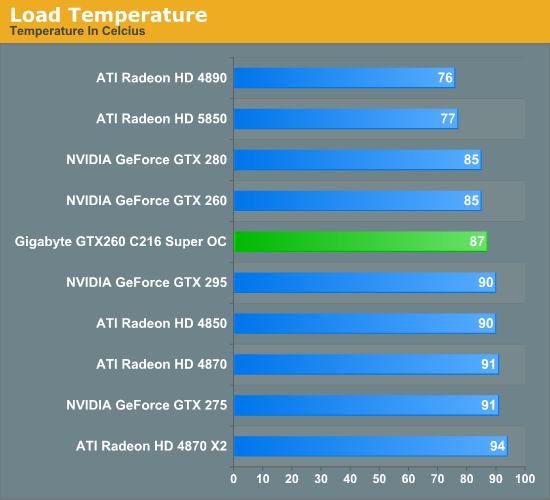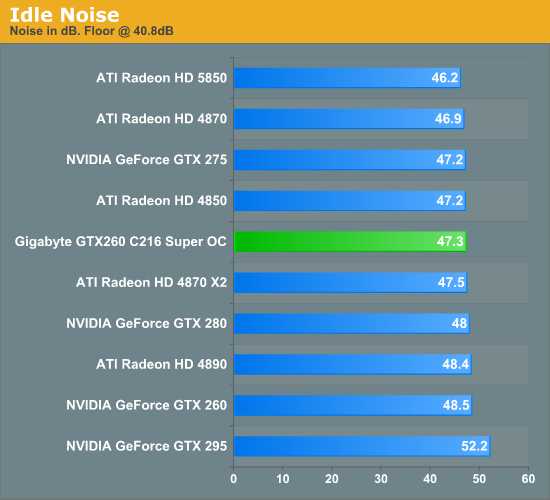Gigabyte's GTX 260 Super Overclock: A GTX 275 on the Cheap?
by Ryan Smith on October 11, 2009 12:00 AM EST- Posted in
- GPUs
Temperature & Noise

The GTX 260 Super Overclock idles roughly at par with the rest of the GTX lineup, coming in behind the GTX 275 and ahead of an original GTX 260. It can’t however touch the 5850, which has a significantly lower idle power uage.

The cost of running a GTX 260 as such high clockspeeds makes itself apparent here, as the GTX 260 Super Overclock ends up being a few degrees warmer than either the original GTX 260 or the GTX 280. However it easily sails in under the GTX 275, which at 91C is pushing the level where the drivers will significantly ramp up fan speeds to maintain temperature.

The noise at idle is in line with virtually everything else we have tested. All of these cards highlight the fact that there exists a point where you can’t get noticeably quieter without going entirely passive.

At load, the GTX 260 Super Overclock comes in under everything else on this chart by at least 3dB. This is where Gigabyte’s binning and tuning become apparent, as they have managed to pick a fairly cool chip, and keep the cooler running at a lower speed for longer. The higher temps we saw earlier are a direct result of the desire to keep load noise lower. The card does get hot enough to drive the fan higher, but less so than if Gigabyte wanted to keep the GTX 260’s original thermal targets. In practice this combination makes it one of the quietest higher-end cards we have tested.










29 Comments
View All Comments
palladium - Monday, October 12, 2009 - link
Just wondering, with HAWX, is DX10.1 enabled for ATI cards?Ryan Smith - Monday, October 12, 2009 - link
No.Nfarce - Monday, October 12, 2009 - link
I just ask because I bought a stock EVGA 275 and have it overclocked quite nicely, which puts it above the performance of this o/c 260. Even AT posted about the 275's performance capabilities in an article back on June 4. You aren't really comparing apples to apples here other than one being purchased factory overclocked and others being purchased factory stock. No serious gamer ever keeps a video card stock just like a CPU.Ryan Smith - Monday, October 12, 2009 - link
Absolutely. User overclocking is by no means guaranteed, whereas factory overclocking is as good as anything else sold.As I stated in the article this card is a poor choice if you intend to do any overclocking on your own, but if you're the kind of person that does not do any overclocking (and I do know "serious gamers" that don't touch their card's clocks) then this is just as good as a GTX 275.
Abhilash - Monday, October 12, 2009 - link
It is not worth the 25% premium over a stock gtx260.Where is the power consumption results???
Ryan Smith - Monday, October 12, 2009 - link
My Kill A Watt decided to kill itself during some testing this weekend. There wasn't time to get it replaced and run new tests while still meeting all of the article deadlines this week. It'll be back soon™.SirKronan - Monday, October 12, 2009 - link
That's what I was wondering from the first page of the review: "Ok, so it performs like a 275, but how much power does it consume to do the same amount of work?" The title and conclusion indicate the performance is there for $10 to $20 less, but I kept looking on the review pages for the only thing I really wanted to know: "How do they differ on power?"I am typically one who praises Anand's articles, but I wouldn't have even published this without at least some kind of power figures. I understand that your Killawatt got "killed" (er... died, heh), but at least give us figures from a UPS that has a wattage meter built in. What was the difference in overall power consumption? That would at least give us an idea of how much extra power the 260 OC'd is going to use versus a 275. If you game enough, the power savings might even nearly negate the extra $10 you save over 2 or 3 years, depending on where you live.
Finally - Monday, October 12, 2009 - link
Thanks for pointing this out. I was about to ask that.I guess that is the card's weak spot that would stand in the way of a "recommendation"...
Under the rug, under the rug...
7Enigma - Monday, October 12, 2009 - link
Ryan did mention in the comments above that his Kill-A-Watt died during testing so that would explain why the info is not there.What should have been mentioned (I may have missed it) in the article was this explaination. No where did I find it, and like most of us my first thought was, OK but how much more power is this thing using, as that makes a big difference in my personal buying decisions (and why the 5850 is so darn likable across the board).
Stas - Sunday, October 11, 2009 - link
As noted, 4890 is $20 cheaper than this Gigabyte card. Performance almost equal. But don't forget that you can easily get extra 100-150Mhz on the 4890 GPU with stock cooling, and 100-200 on memory. Which would make it 5-10% faster. So now we have a card (HD4890) that's cheaper ($20) AND faster than Gigabyte GTX260 O/C. I think it's a no brainer. Of course, Gigabyte did a great job with this card (I love Gigabyte), but you can only compete so well, when the limitation is set by the chip's architecture. Out of all GTX260 cards, this one is probably the best. But it isn't the best value or performance when compared to HD4890.P.S. Even with both cards at stock, in games where GTX260 prevails, it only does so by 10% or so. Wherever the HD4890 comes atop, it beats the other by up to 30%.